Armed Forces
Italian commitment on the "Miecznik” program [INTERVIEW]
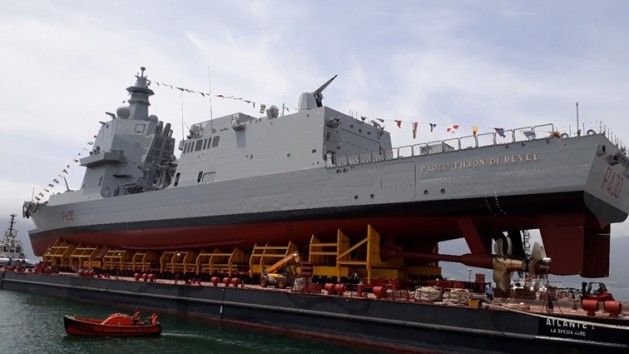
The Leonardo and Fincantieri companies are planning to propose to the Polish Navy their new PPA (multifunctional patrol vessel), which according to the Italian companies meets the requirements set for the coastal defense ship set out in the „Miecznik” program. Details on this unit were presented by Italian specialists in an interview for Defence24.pl., hereby reported.
Marco Lupo, President of Leonardo Poland and GianFranco Abbrescia, CCO Naval Product Marketing and Strategic Campaigns, Leonardo: Why are Leonardo and Fincantieri companies offering Poland their new PPA (Pattugliatore Polivalente d'Altura) multifunctional patrol vessel in the Miecznik program, instead of the Bergamini FREMM frigates? After all, it is the FREMMs, and not PPAs, that serve as the basis for the construction of the new American FFG (X) Constellation Class frigates.
Maksymilian Dura, Defence24.pl: To this end, the PPA is designed to be fully modular, i.e. it can be configured, with a scalable platform and ship combat system components, to higher configurations in a very short time.
Three versions of the PPA are being developed to meet the requirements of the Italian Navy, designated "Light", "Light Plus and “Full". The last one has full combat capabilities, while the first two lack of some equipment that can be easily installed (fitted for level one) to be upgraded to the "Full" configuration,. This approach reduces the initialprocurement costs, increases the flexibility, and facilitates the introduction of new technologies, in the future.
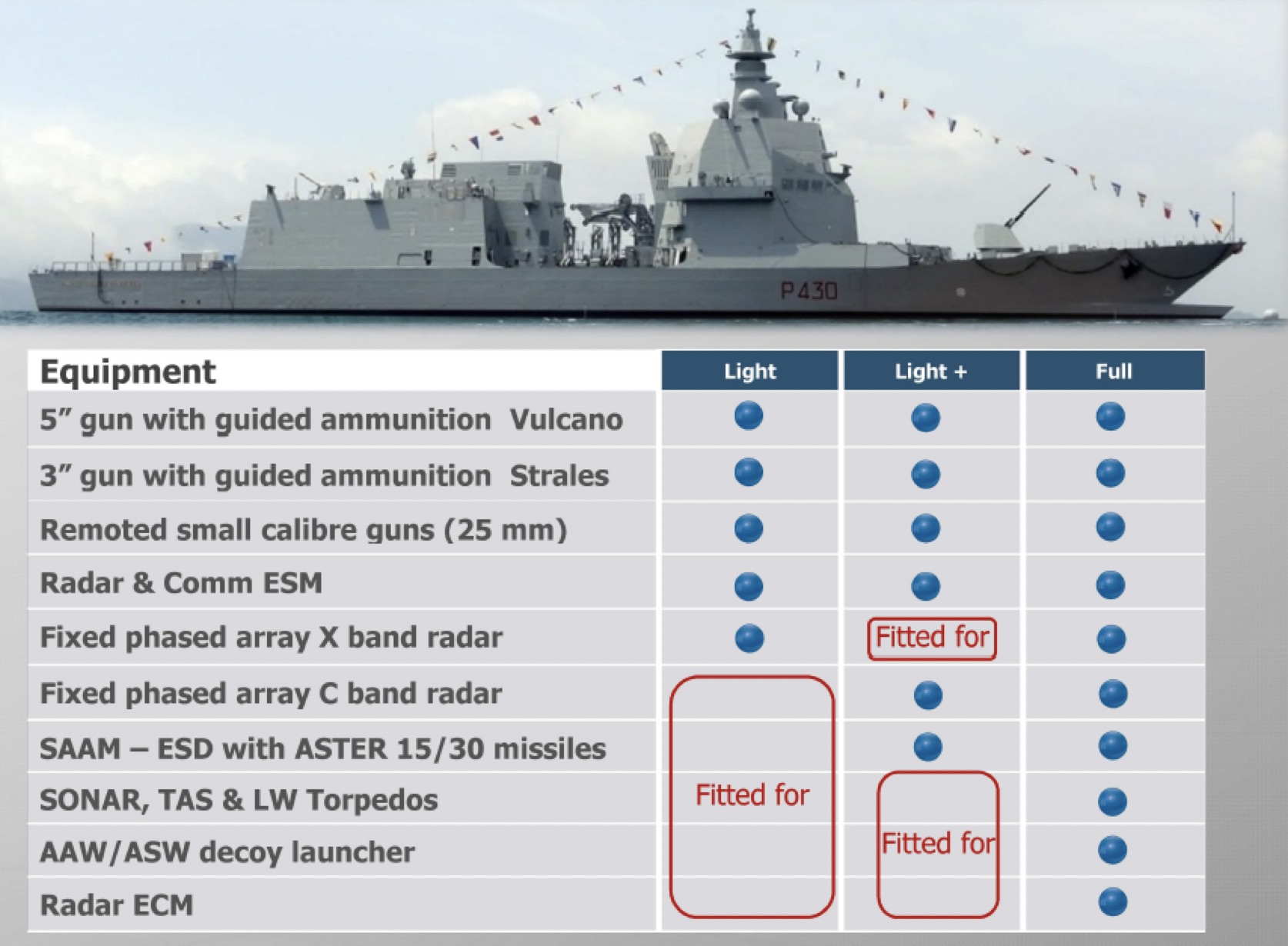
Furthermore, the PPA design includes two modular areas (one amidships and one astern, below the flight deck) capable to receive the so-called “additional mission modules”. If necessary, they allow adapting the ships, e.g.:
- to carry out humanitarian missions and provide assistance during natural disasters (by assembling HADR modules - Humanitarian Aids and Disaster Relief);
- to carry out operations with unmanned systems (by assembling modules with surface and underwater vehicles)
- to support special forces operations (through the installation of RHIB’s and specialized commando equipment).
All these modular features make the PPA operationally flexible, making it able to be tailored to a wide variety of missions. Hence its name: "multi-role."
From the point of view of on-board systems, the PPA project provides the most advanced technology in the world, as described below
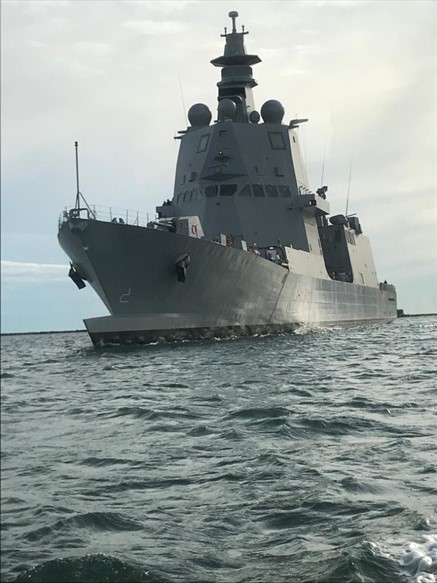
The latest version of the ship's SADOC4 CMS (Combat Management System) provides full control of the ship’s equipment through multifunctional multi-touch 43-inch (screen) consoles, using a smart HCI similar to the one present on modern smartphones and tablets. Integration of different types of unmanned systems is also possible.
For these reasons and because of our understanding of the requirements in the "Miecznik" program, we are ready to offer the PPA to the Polish Navy, because it is the ship with the highest level of operational flexibility available in the today’s market. Of course, we are also open to propose a solution based on the FREMM frigates, which is the most modern ASW frigate in the world, and includes powerful AAW and Surface Strike systems.
As you can see, Leonardo and Fincantieri have already taken into account in their proposal that the Polish Navy may require larger ships - frigate class, and not just patrol ships with limited capabilities or corvettes. But does the PPA offer meet all the requirements set by the Polish side? Especially if we take into account the factthat these ships will be used both in the Baltic, where A2/AD systems prevail, and on the open seas and oceans - as part of multinational ship groups, where high autonomy is crucial.
Despite PPA is a patrolling vessel it is equipped with the most advanced systems developed for the ITN, such as:
- The new fixed antenna array Kronos® Dual Band Radar (DBR), operating in the C and X bands is a multifunction system capable of automatically carrying out more operations at the same time. This AESA radar can:
> support local area and self-defence;
> provide Fire control & Missile Guidance;
> achieve excellent performances also in the littoral environment;
> provide Ballistic Missile detection and tracking capability; - The new Multi-Sensor, dual-band, Fire Control System NA30S Mk2 radar;
- The new IFF Circular Array Interrogator SIR-M5-C EVO, fully Mode 5 Level 2 capable.
- The new Distributed Static-Staring Infrared Search & Track (DSS-IRST) system, capable of real-time 360° passive surveillance and tracking around the ship. The video provided by the distributed IR system are available inside the ship on the CMS consoles, on large screen displays and possibly on Helmet Mounted Displays;
- The new Active Towed Array Sonar (ATAS), a modular and light-weight variable depth sonar.
On top of that, we also have powerful effectors, such as:
- The 127/64 medium calibre gun, capable of firing the Vulcano guided ammunition, which have an extended range, for Naval Gunfire Support (NGS).
- The 76/62 “Sovraponte” (non-deck penetrating) medium calibre gun, capable of firing the DART guided ammunition. This system’s unique capabilities allow performing a number of different tasks (surface and anti-airdefence , CIWS and in the near future NGS, as the 76/62 ER ammunitions “mini-Vulcano” are under certification), providing a much greater flexibility if compared to traditional gun configurations.
- The Aster 15/30/B1 AAW missile system, which (upon upgrade to the NT version) can provide, combined with the Kronos® Dual Band Radar, among the other features, ballistic missile defence.
- The Teseo Extended Range SSM system (as an option) for Surface Strike (Naval and Land).
- The Light-weight Torpedo (LWT) Launching System for MU90 torpedoes and other NATO standard LWT.
- The AAW/ASW decoy launching system.
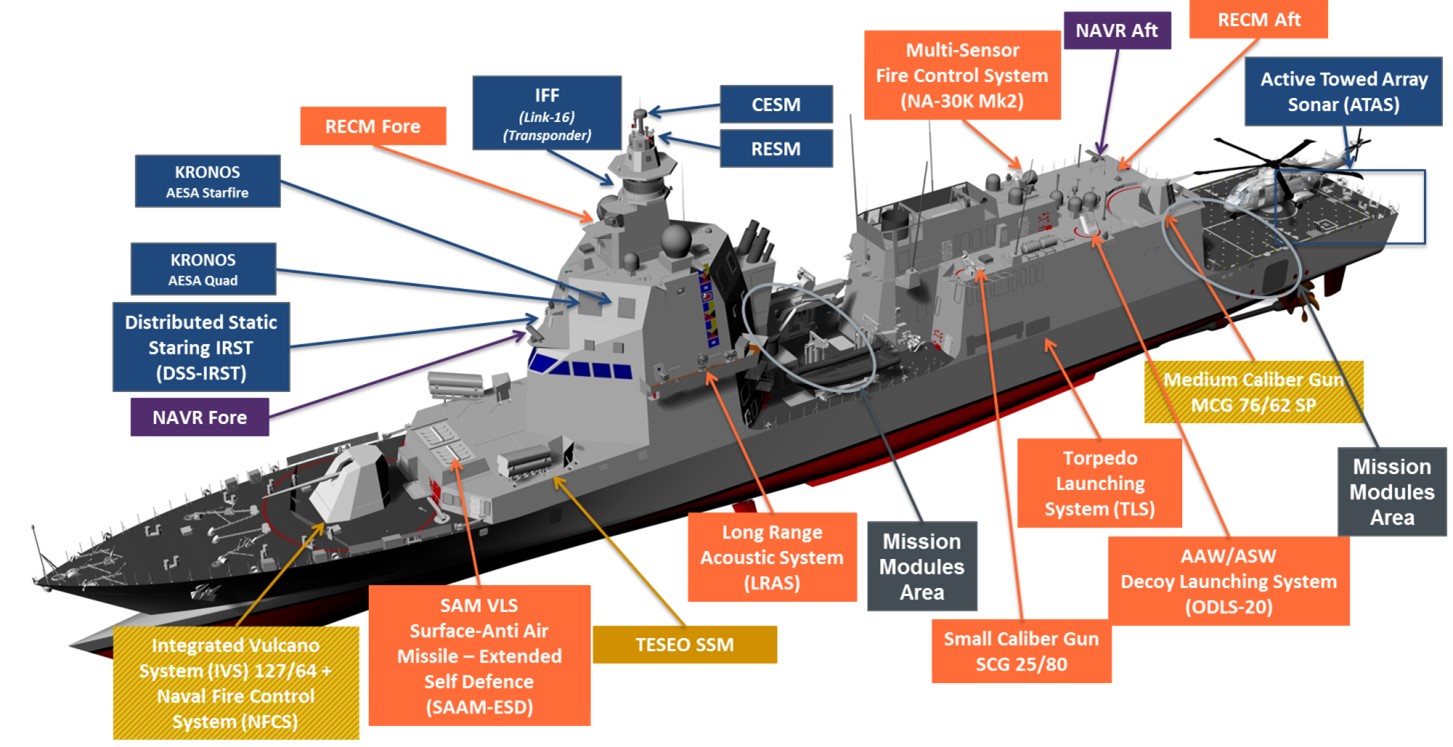
From platform's capabilities point of view, the CODAGOL (COmbined Diesel And Gas Or eLectric) propulsion system can provide: either high speeds (over 31 knots), propulsion configurations with controlled acoustic signature, or very efficient economic cruising speeds with increased range.
The above capabilities will certainly allow PPA ships in "Full" configuration to operate in A2/AD bubbles in the Baltic, in open seas and oceans and as part of multinational ship groups with high levels of autonomy. We believe that no other offering provides such a powerful and flexible solution with a very wide range of advanced technologies in the world.
Can missile systems designed for the "Full" version of PPA ships be mounted on the "Light" and "Light +" versions, if necessary?
As already mentioned, all versions of the PPA are fitted for the "full" version of the combat system, which also applies to missile systems. In particular, the Italian Navy anti-aircraft missile system is based on vertical launchers capable of firing all MBDA Aster missiles (15/30/B1 and NT in the near future) missiles. This provides the user with great flexibility in selecting the effector appropriate to the situation and threat.
Will missile and artillery sets for PPA ships be purchased for the Italian Navy in numbers equal to the number of ships of this type planned to be built?
So far, the Italian Navy has contracted seven PPA ships from the Fincantieri/Leonardo consortium. Three of them will be delivered in "Light" version, two in "Light Plus" version and two in "Full" version, the ship’s combat system equipment will therefore be purchased in accordance with each version configuration, and for the corresponding amount. As explained earlier, each version can be eventually easily upgraded to "Full" by purchasing and installing the specific hardware.
Due to the increased power requirements of the "Full" version, are there any changes planned in the propulsion system: engines and generators for this version as compared to "Light" and "Light Plus"?
The PPA power generation system is based on four "generator sets" with a capacity of 1.6 MW each. The ship has been designed to allow upgrading from the basic ("Light") version to the full ("Full") version with a "plug-and-play" principle, without the need of making any change to the ship's core systems. Therefore, all major platform systems will remain the same in all three PPA versions. In particular, this applies to the power generation and propulsion systems that are already dimensioned for all requirements of the "full" PPA version and are based on the CODAGOL configuration.

This means that the electrical power available for PPA is tailored to the ship’s "Full" version.
As I understand, the PPA ships have the innovative CODAGOL propulsion system. What are its components and what is the advantage of this solution over other drive configurations such as CODLAG?
The speed requirements of the PPA are very demanding, both in terms of maximum speed (exceeding 31 knots) and in terms of maximum speed achievable only on propulsion diesel engines (not less than 25 knots), at the same time, the ship is required to operate at low speed during long-lasting patrol operations.
To fulfill the above requirements we conceived a propulsion configuration based on a CODAGOL (COmbined Diesel And Gas Or eLectric) architecture. As shown in the following picture it is based on one LM 2500+G4 gas turbine (32 MW), two MTU 20V 8000 M91L diesel engines (10 MW each), a cross-connected reduction gear and two electric motors (1.35 MW each) connected to the shafts by means of two auxiliary reduction gears. When the ship sails at loitering speed (less than 10 Knots) for a long period, the propulsion on electric configuration permits to shut off the main propulsion diesels, avoiding them to work at very low load (undesirable condition, especially in case of big size diesel engines like those of PPA).
As you can see the propulsion and power generation system are optimized to work in the best conditions at different speed, thus reducing the fuel consumption and emissions.
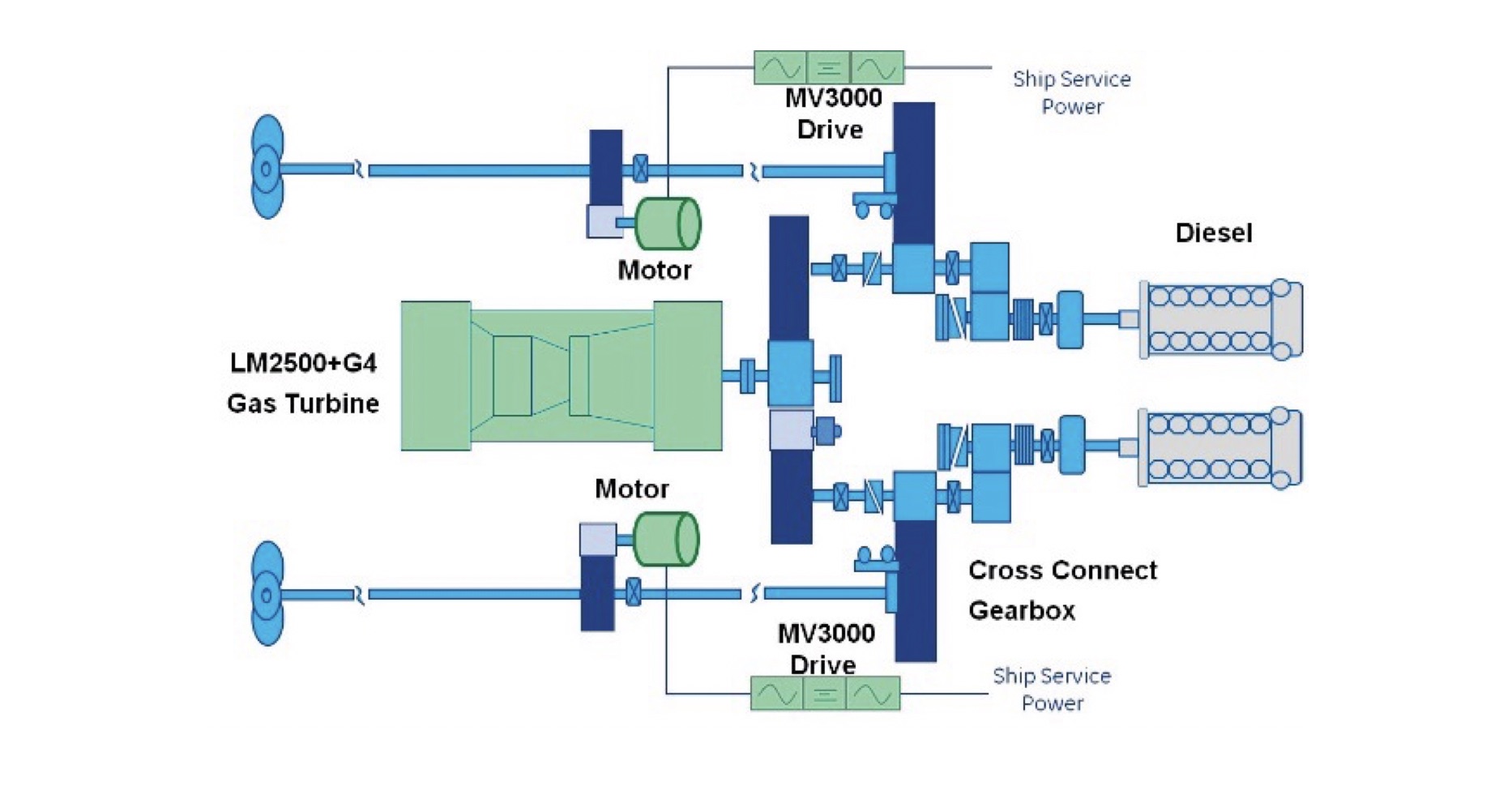
Of course, we cannot state that CODAGOL architecture is better, compared to CODLAG and vice versa, but we can say that the two solutions are suited to different speeds and different operational requirements. In fact, the CODLAG configuration, chosen by Fincantieri for the FREMM frigates, allows, specifically in anti-submarine warfare operations (the main requirement for FREMM, not for PPA), to operate on very quiet propulsion using the "electric propulsion” asset with cross-connected reduction gear at stand still, but does not allow the high speed required for the PPA ships.
Were the speed requirements the reason for the specific bow layout with the extended underwater part of the hull?
Yes, but not only that. The speed requirements we had from the Italian Navy (25 knots in a diesel-only configuration and over 31 knots as the maximum speed with a gas turbine) were very demanding and had a big impact on the ship’s design.
For this reason, Fincantieri decided to use a "Wave Piercing Bow", designed to improve hull performance. It is characterized by a sharp underwater bow projection that cuts through the water with ease and reduces the angle of entry into the wave of the bow section while increasing the length of the waterline. This enhances comfort on the high seas by suppressing vertical motion and improves the hydrodynamic performance.
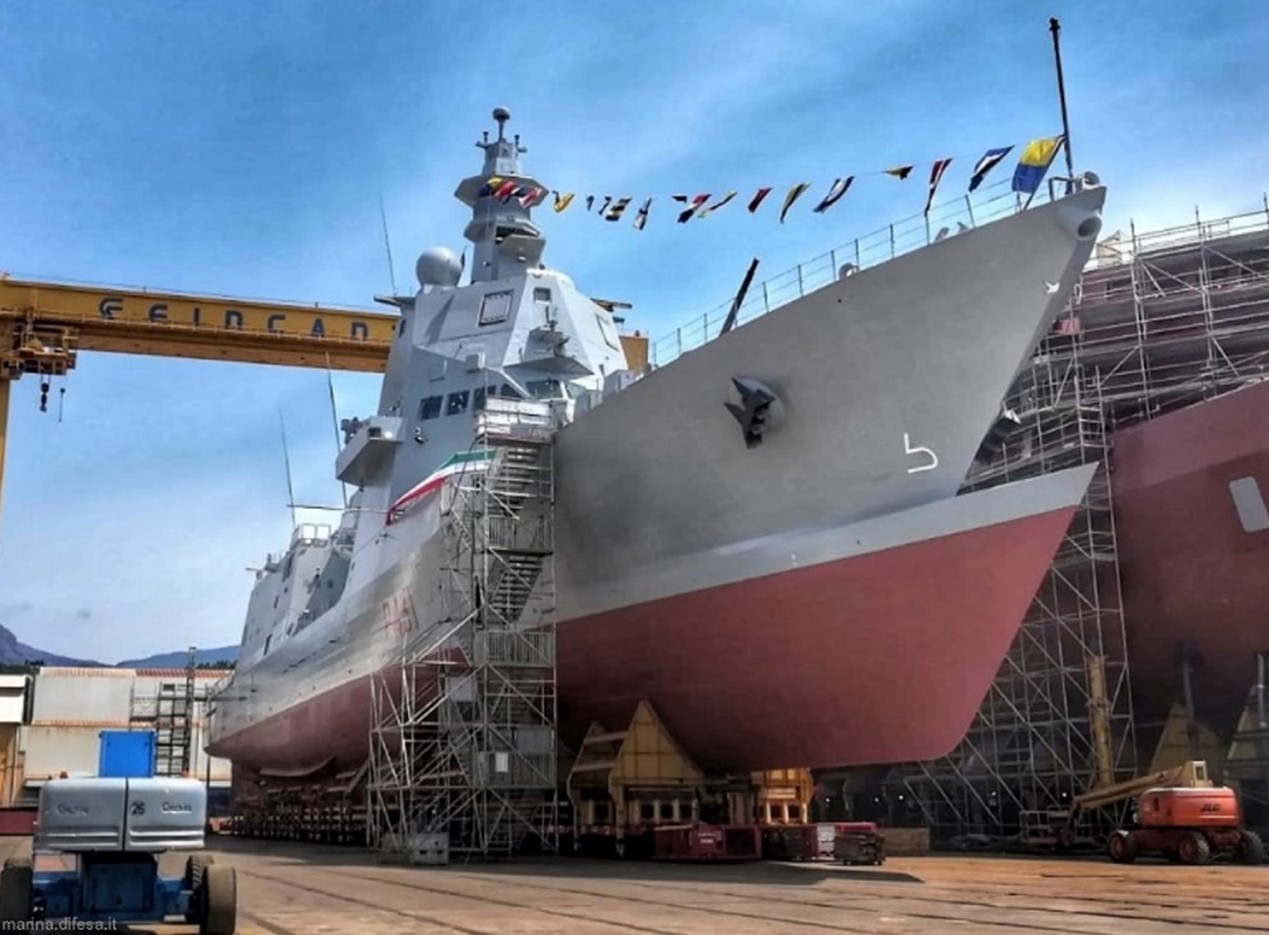
What is the greatest value in Leonardo's proposal for the Miecznik program involving PPA ships?
As we have stated before, we are offering the Navy a very advanced ship design. The PPA ships in fact incorporate state-of-the-art features:
- Modularity and expandability: this is an extremely important factor, as allows the PPA configuration to be tailored to emerging threat scenarios for the next 20-30 years. In fact, it will be possible to introduce new technologies and products (sensors and effectors) and reconfigure the ship combat system in accordance with the evolving doctrine and operational missions of the Polish Navy;
- State-of-the-art technologies: the same new developments that the Italian Navy is currently pursuing under the PPA program will be made available to the Polish Navy without risk, associated costs and development time.
Our proposal for local construction and technology transfer is very interesting, because if we can conclude all the planned cooperation agreements, it will result in Polish companies being able to take a giant step forward in terms of capabilities and knowledge.
Modular construction of the equipment was and is also proposed by other shipyards in the world - including Danish and German. What is so unique about the offer proposed by Leonardo and Fincantieri?
In recent years, the concept of modularity in ship design has been addressed differently. For PPA, it was decided to take advantage of the presence on the market of a large number of containerized solutions, prepared for different tasks (containerized hospitals, living modules, containerized solutions for typical maritime tasks, etc.) this permits to embark ad-hoc resources in a very short time without interfering with ship systems and on the operativity of the ship. For this reason, Fincantieri has designed a ship with two separate modular areas, one is located amidships and the other astern - under the flight deck.
The modular areas provides the opportunity to further expanding ship's capabilities in the future, by introducing on board new generation equipment (such as unmanned systems, electronic warfare equipment, etc.). The alternative set of mission modules also includes modules needed for operations such as HADR (Humanitarian Aids and Disaster Recovery) (i.e., field hospitals, additional sleeping quarters, etc.). All of these modules can be unloaded when not needed, thus freeing up space for other types of modules, thus increasing the flexibility of use of the same ships.
You mentioned two dedicated purpose decks on the PPA ship. What possibilities for container cargo does the area designed amidships have?
The central modular area (amidships) is sized to host up to eight ISO 1C containers with a maximum weight of 120 tons and has autonomous capacity to load/unload the containers by its own central crane, capable of handling cargo weights up to 20 tons@ 14m (up to 10 tons at sea).
A davit double-arm folding crane with a total lifting capacity of 10 tons (5+5) is used to launch and recover boats up to 13 meters long.
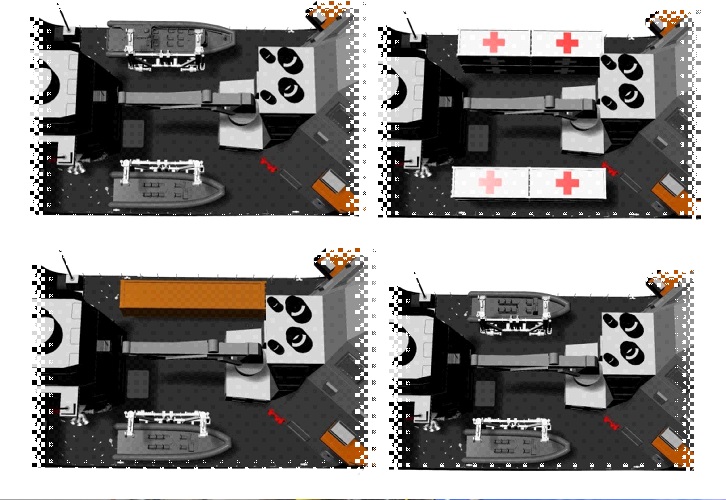
Who is the supplier of the amidships mounted multi-purpose crane?
Every maritime program has multiple suppliers of various on board components. We tend to prefer suppliers who provide the most critical products because we have developed a fruitful relationship with them over decades, trust them, and have good relationships on technical and commercial reliability. Suppliers of non-basic elements for future ships of the Polish Navy will be agreed with the Client.
Back to the purpose decks. What are the possibilities for the modular area located at the stern?
The stern reconfigurable modular area (located below the flight deck) can be loaded using a removable section of the flight deck itself, from the stern ramp and through two large openings in the ship's sides. The movement of containers from land to ship and vice versa is not autonomous, but is performed by the port's cranes via the opening on the flight deck. This modular area is equipped with all necessary connections to make different types of containers work in a "plug-and-play" mode.
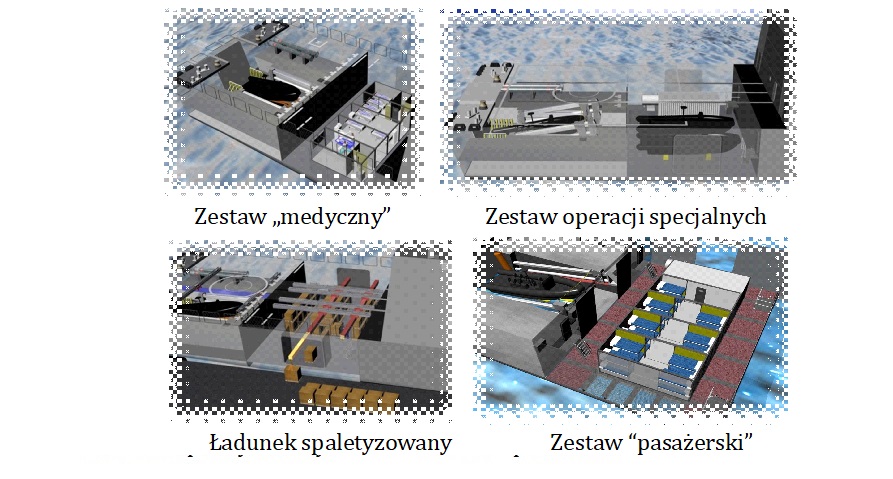
RHIB’s can be lauched through a stern ramp, and the boats can then be moved forward into the modular area via a watertight sliding door.
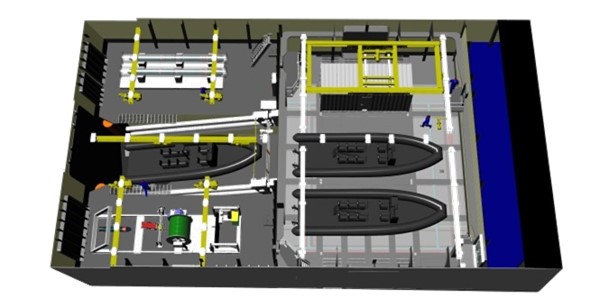
If we are already on the flight deck, please clarify: what type of helicopters will it be designed to accommodate, and is it planned to be used for drones?
The flight deck is dimensioned for the EH101 and NH90 or AW159 maritime helicopters and the hangar can recover one EH101 or two NH90 or two AW159. Of course, using drones from the flight deck is possible. The PPA, moreover, will have the organic capability to interface (by means of the ship's command and control system) with the AWHERO mini RUAV (Rotary Wing Unmanned Vehicle).
What does multi-tasking and full integration between platform and combat system means in practice, for the Italian Navy and especially for the Miecznik program?
The high level of automation and integration of shipboard equipment provides many benefits to any Navy:
- Automation reduces the workload for operators allowing them to focus on the most demanding tasks avoiding lower-level routines;
- The integration between the platform and the combat system allows ship's resources to be optimized according to specific, instantaneous tasks, and provides unique insight into the status and condition of the ship's systems at a higher level of capability;
- Automation and integration reduce the crew size. This is particularly evident in the design of the innovative integrated bridge the so-called "NAVAL COCKPIT" because it uses conceptual solutions derived from aircraft. As a result, some tasks can be accomplished with just a few person.
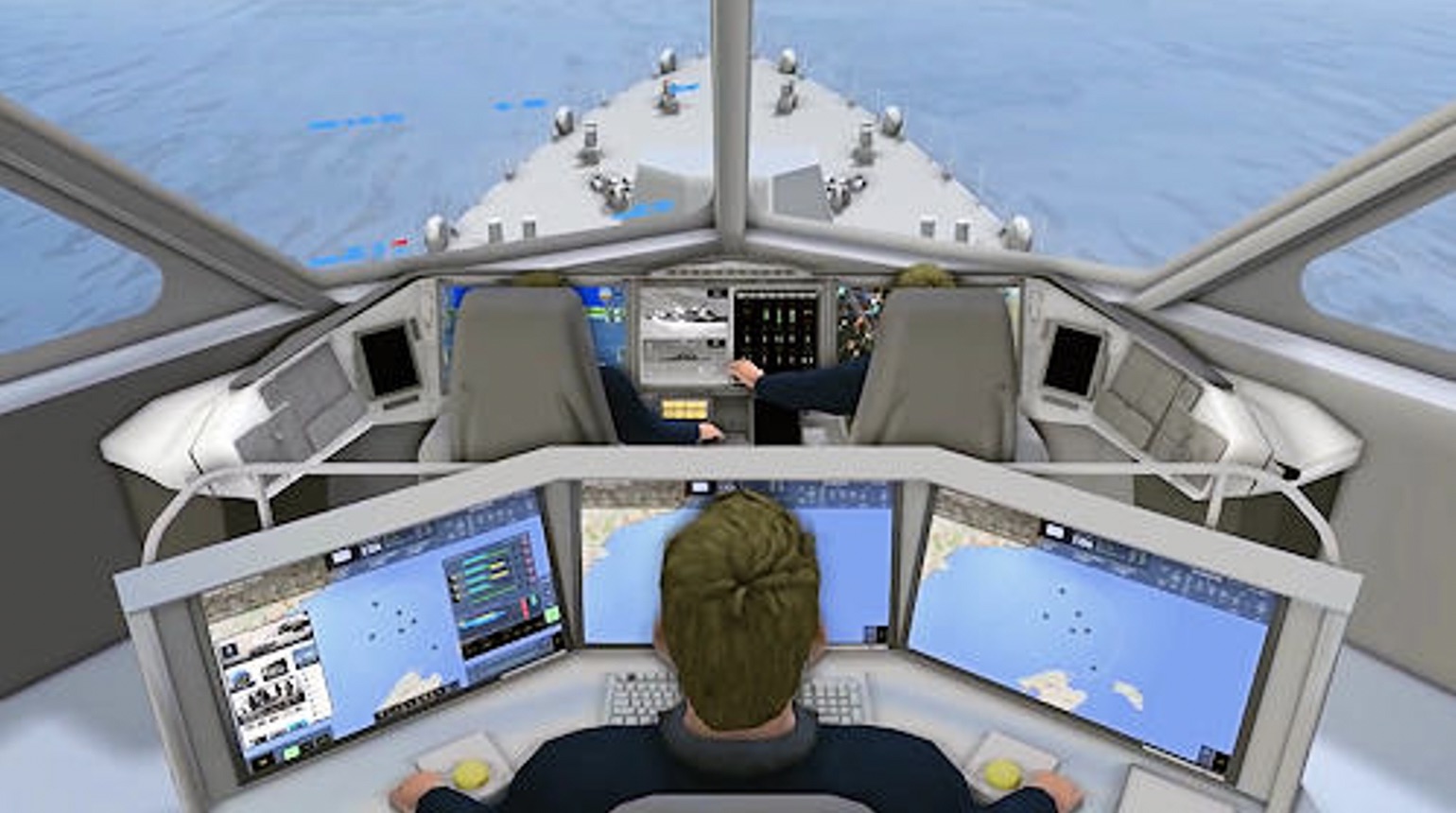
Which ship command and control system will be used in the PPA and in what equipment configuration?
The combat management system adopted for the PPA ships built for the Italian Navy is the newly developed SADOC4 CMS, which has a number of extremely innovative and unique functionalities, such as:
1. Advanced operational capabilities:
- A complete solution for any type of warship, from coastal patrol vessels to frigates, support ships or aircraft carriers, flexible and ad-hoc configurable;
- Fully integrated presentation and management of tactical situational awareness;
- Management and coordination of all combat system assets, sensors, and weapons and full integration with the platform systems.
2. High level of integration and automation of the system:
- Automatic integration of sensor data, and video presentations;
- Automatic coordination of weapon systems (threat assessment, action planning and weapons control during combat), reducing the operator's workload under critical conditions;
- Automatic response to simultaneously occurring threats, above and below the sea surface;
- Integration with multiple tactical data links and command support systems for a high interoperability.
3. System performance and reliability:
- New state-of-the-art software and hardware component technology designed to fit a variety of solutions;
- Continuity of operational functions without data loss.
The SADOC4 CMS (also named Athena®) is based on a newly developed 43" UHD multi-touch console, with a lightweight carbon fiber construction and a new user interface based on the modern "smartphone" interface.
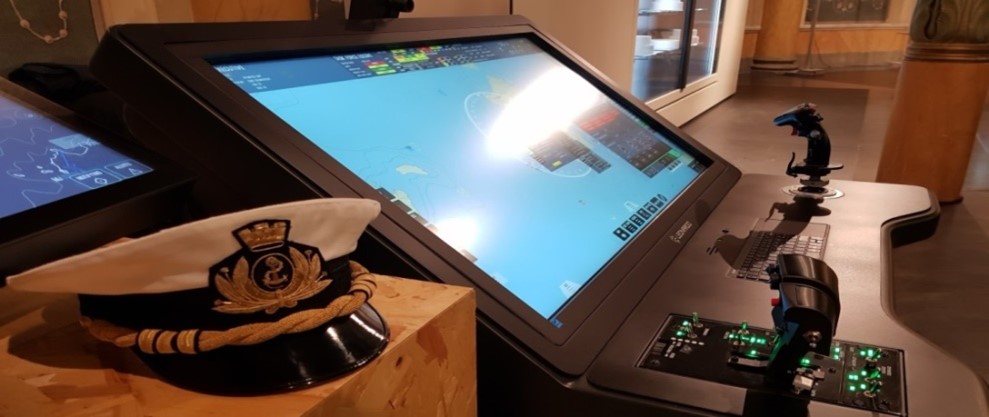
A new Naval Tactical Table (NTT), designed to facilitate decision support tasks, and a Mission Wide Wall Screen (MWWS) providing a full view of the external situation outside the Combat Information Center complements the command and control system's user interface.
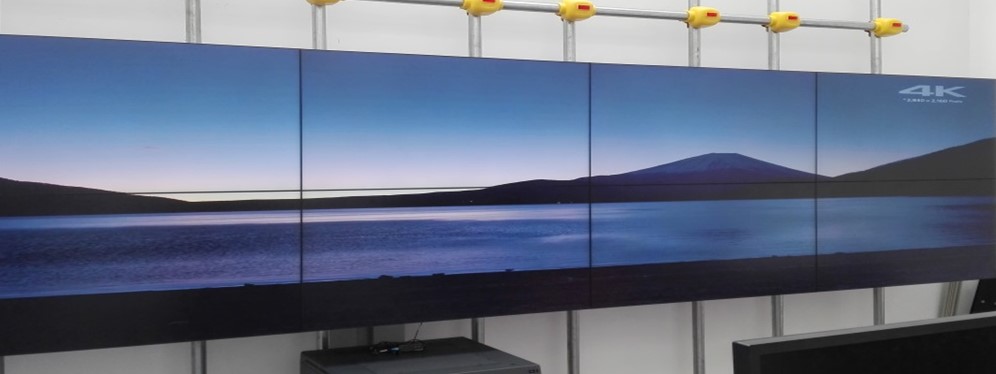
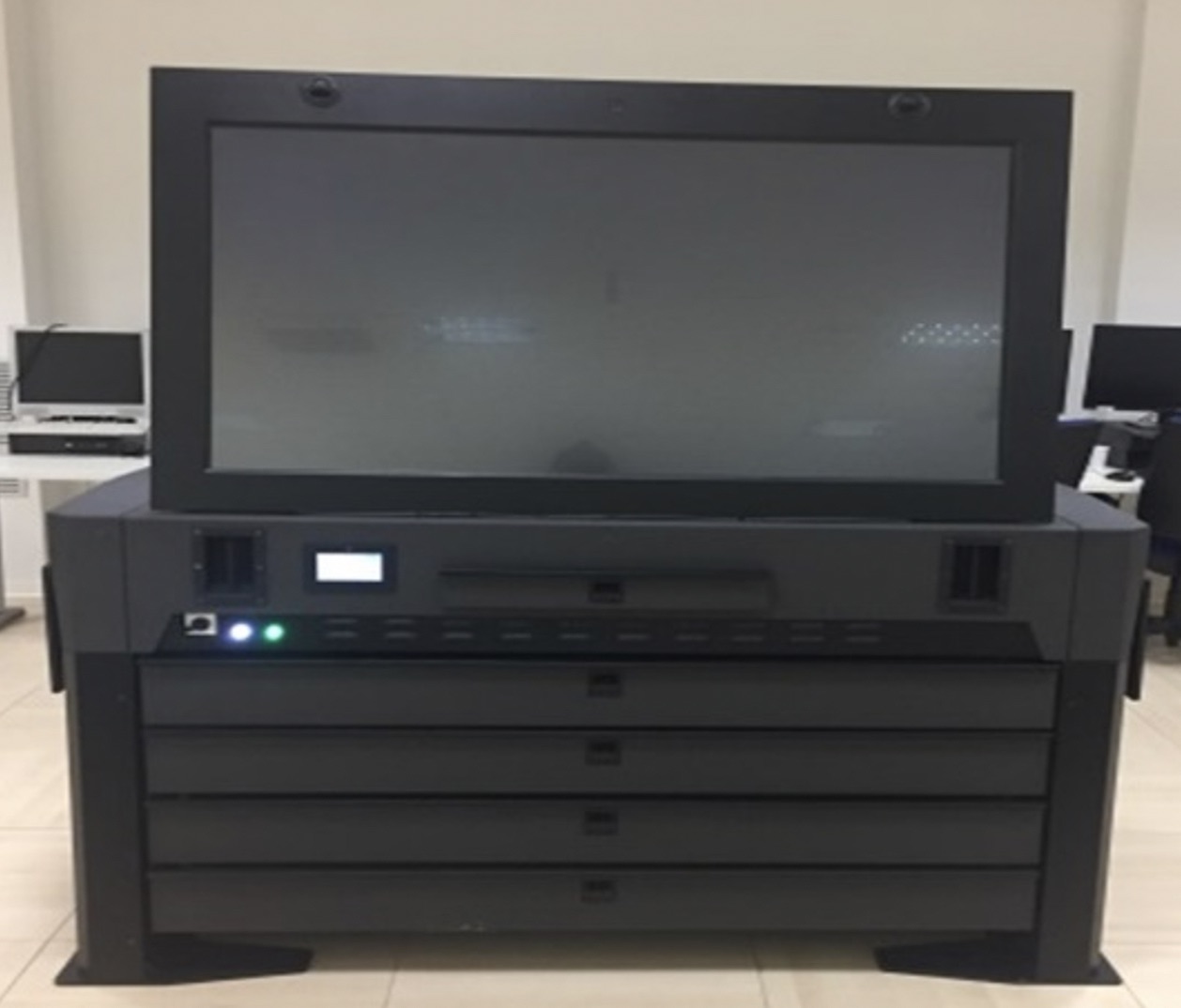
What role does Fincantieri play in the whole PPA project and what is Leonardo expected to deliver?
Implementing new ship programs for the Italian Navy (besides the PPA there are also a Logistic Support Ship and a Landing Helicopter Dock programs in progress) Leonardo and Fincantieri have established a consortium acting as single contact point. In particular, Fincantieri is responsible for the design and construction of entire ships, and Leonardo for the design and development of fully integrated combat systems.
What are the advantages of using one class of PPA ships instead of more than one?
As we explained earlier, PPA ships are very flexible with a scalable Combat System(especially in the "Full" version). As such, the benefits offered by PPA, especially when compared to other older and more "traditional" ships, are multi-fold:
- Increased flexibility for use in various scenarios and theaters of operations;
- Reduced need to acquire different classes of ships;
- An innovative design with an impressive number of newly developed technologies applied;
- Lower purchase cost, as it is possible to make a "Light" or "Light Plus" version for simpler tasks and upgrade it at a later stage if necessary;
- Reduced operational costs, since with a single class it is possible to perform the same tasks usually requiring different types of ships, thus achieving great economic benefits, great savings in crew training and logistic support (maintenance, repair, overhaul and modernization works), easier securing of spare parts chains, etc.
- Reduced costs for integrated logistics support, as PPA vessels in Italy are procured with an ILS Contract for Availability which has already been tested with the FREMM program and has shown impressive savings (compared to the traditional ILS model), significantly increasing the availability level of this class.
The command and control system installed on the PPA ships allows operating independently, as part of a NATO naval force, as a flagship, in coastal operations and in "blue" waters ... Please name another existing ship capable - within the same size and displacement - of competing with PPA!
We believe there is no comparable offering on the market today that is so innovative, with such cutting-edge technology, and yet so economical from both an acquisition and lifecycle perspective.
Thank you for your time.
